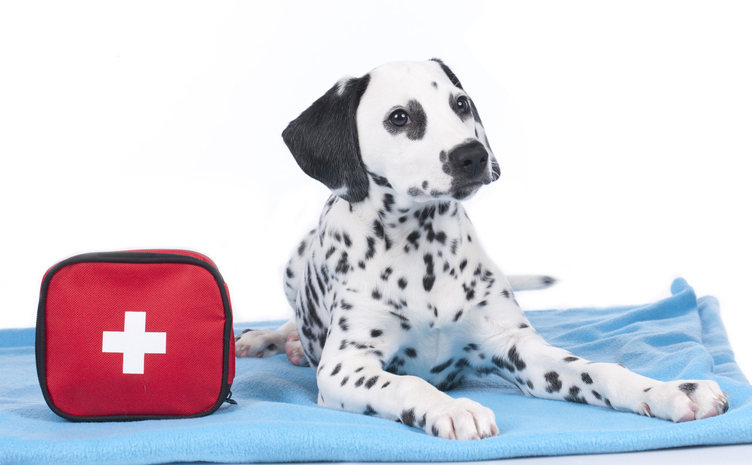Emergencies happen, even to pets. But not all owners know how to go about performing pet first aid. Unfortunately, many pets will find themselves in situations where first aid could save their lives or reduce injury. Knowing the basics of first aid can increase the odds of saving your pet by 25%. This is why in honor of National Pet First Aid Awareness Month, we wanted to share the fundamentals to help you better prepare if your pet needs first aid.
The 6 Most Common Pet Medical Emergencies & How to Respond to Each
1. Severe Bleeding
Excessive bleeding from a cut, laceration, or wound is the number-one pet emergency. The sight of blood may make some pet owners queasy, but if you can overcome the initial shock, you have the opportunity to improve your pet’s prognosis.
If your pet has a severe cut, the first thing you want to do is leash or restrain your pet. Many pets have instincts that tell them to run and hide when they become injured–and that’s the last thing you want.
Remember that most pets, especially dogs, may feel vulnerable or scared and react by snapping, growling, or biting. Never put your safety at risk. You should try to muzzle your pet. If you have a second set of hands, use them.
After you’ve restrained your pet, you will want to apply gauze or a clean cloth to the cut. Apply firm, even pressure for 3-to-five minutes. If clotting does not occur during that time, continue to apply pressure and bring your pet in ASAP.
If your pet’s bleeding stops, bandage the wound and give us a call. We will ask you some questions to determine if your pet needs immediate treatment.
2. A Broken or Fractured Bone
If your pet refuses to put weight on a limb, there is a sign of an obvious break, or experiences a trauma (such as getting hit by a car), you do not want your pet making the injury worse. The best response is to carry your pet or place them on a makeshift stretcher and bring them in.
3. Choking or Trouble Breathing
Struggling to breathe constitutes a life-threatening emergency. If your pet is choking or stops breathing, give us a call right away.
After calling us, you will want to do a visual inspection to see if your pet is choking on something. Be careful not to get bit, but do a quick sweep of the mouth. Never put your finger in the back of your cat’s mouth–they have fragile bones that will easily break.
If you can see the obstruction but cannot dislodge it, bring your pet in ASAP. As you make your way in, you can attempt the Heimlich maneuver. Here is how to do so for dogs:
- Hold your dog on your lap, feet up.
- Use the palm of your hand and push firmly below the rib cage, five times.
- Roll your dog on their side and check to see if the obstruction came out.
4. Ingesting Poison
The first thing you should do is call us or the pet poison helpline at 855-764-7661. They’re available 24/7. If it’s determined that you should bring your pet in, take the time to grab the item your pet ingested. This will give us a better idea of how to treat your pet.
5. Seizure
Pet seizures can be quite frightening. Do your best to stay calm if your pet has a seizure. The calmer you are, the more capable you are of helping them.
Move your pet away from any items that they could knock over or edges they could fall off of.
Do not put your hand near their mouth–they could clamp down on you unintentionally. Dogs cannot choke on their tongues and neither can most other pets.
If the seizure lasts more than a few minutes, put cool water on your pet’s paws and move a fan on them. Seizures make the body heat up and can cause your pet to overheat.
Give your pet space but talk gently to them.
Call us as soon as you can.
6. Heat Stroke or Heat Exhaustion
When a pet overheats, it can have permanent consequences. Once a pet gets to the point of heatstroke, its body cannot bring its core temperature down. Immediately remove your pet from the hot environment.
To bring your pet’s temperature down, you will need to wrap them in a damp towel or pour room temperature or cool water over them. Cold water could send them into shock, so test the temperature with your hand, first.
Allow your pet to drink as much water as they’d like and bring your pet in.
7. Severe Vomiting and Diarrhea
It’s normal for pets to vomit or suffer from diarrhea from time to time. The trouble arises when these problems go on for too long or if there is a lot of blood in the vomit or diarrhea.
If your pet begins to look listless, weak, or in pain, it’s an emergency. Otherwise, if they continue to have diarrhea for more than 24 to 28 hours or vomiting spells for more than twelve hours, bring them in.
For diarrhea, you will want to feed your dog a bland diet. Chicken and rice soup is a great choice.
Often, for vomiting, waiting it out is your best option. Provide access to water, but do not feed your pet until they are ready to eat on their own.
Be Prepared. Your Pet Will Thank You.
When it comes to pet first aid, knowing what to do could save your pet’s life. If you are ever unsure if your pet should be seen by our team, give us a call. No question is too small or too silly when it comes to your pet’s wellbeing.
Wishing you and your pet the best of health this month and beyond.



